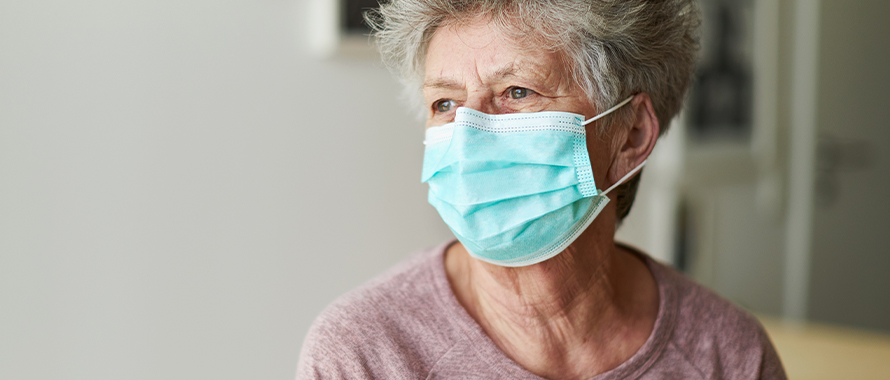Close quarters, widespread shortages of protective gear and extremely vulnerable populations have led to high rates of COVID-19 infection at senior living facilities. Long-term care facility leaders face an uphill battle to keep residents safe, comply with new regulations and contend with potential or actual court battles related to COVID-19.
Senior living facilities, home to 1.3 million individuals in the U.S. and about 7 percent of seniors in Canada, have been hit exceptionally hard by COVID-19. A recent New York Times analysis showed that more than 10,500 of lives lost to coronavirus in the U.S. were residents and staff members at nursing homes and long-term care facilities; this represents nearly a quarter of all lives lost to COVID-19 nationwide.
“Senior living facility leaders and staff are responding to a disaster,” said Maggie Karnick, Senior Underwriter, Professional Liability, Burns & Wilcox, Chicago, Illinois. “The staff at these facilities really are heroes. They continue to show up and do the best they can at an unprecedented time while guidelines and regulations seem to change almost daily.”
Lawsuits are a growing concern for these facilities. Suits have already been filed against nursing homes in places like North Carolina and Washington and experts predict more will follow.
“If family members perceive that their loved ones are not receiving appropriate care due to COVID-19-related requirements and protocols, I would anticipate an increase in litigation, potentially for caregiving malpractice and bodily injury,” said Christian Hamlin, Senior Broker, Burns & Wilcox Brokerage, Los Angeles, California.
New regulations and a push for liability immunity
New guidelines affecting senior living facilities include federal transparency requirements around reporting COVID-19 cases, in addition to individual state mandates that ban visitors and require temperature checks for staff and adherence to isolation rules for residents.
In at least three states, nursing homes are also barred from turning away new or existing patients who test positive for COVID-19 at a hospital but are discharged and deemed “medically stable.” This has prompted some family members to remove their non-infected loved ones from care facilities over fears they will be infected by patients returning from hospitals to recover.
Staffing shortages, a challenge for senior living facilities before the pandemic, have been compounded as employees fall ill with COVID-19.
“It is a perfect storm,” Karnick said. “Nursing homes are in a tough place right now.”
The flood of lawsuits that could follow the crisis has organizations representing long-term care facilities advocating temporary immunity from litigation for alleged negligence. At least six states currently provide some form of immunity; six other states offer some form of immunity for health care providers, which some legal experts interpret as applicable to nursing homes.
“Care providers are under a tremendous amount of stress. Not only do they worry about their residents, they worry about their own health and safety as well as their family’s health and safety. This stress is magnified with additional concerns over potential malpractice lawsuits as they do their best to respond to the COVID-19 global pandemic,” Karnick said.
Such immunity is not absolute. “It is obviously going to be up to the courts,” Karnick added. “There are precedents for health care immunity, however not to the extent some of these states are suggesting. There needs to be clear written state and federal government guidelines, no one should be immune from liability for total gross negligence.”
Insurance enhancements help with evacuation, crisis management
While some states, like Florida, where long-term care facilities have been hit the hardest, have offered emergency provisions and funding for supplies, cleaning and staffing, there are many needs left unmet and added expenses incurred. Professional Liability Insurance can help to mitigate those costs and shore up funding gaps for the cost of operating during the current crisis.
“There are many coverage considerations to address in this current crisis, including those related to bodily injuries or regression in residents’ conditions when therapies are withdrawn,” said Karnick.
Additional Professional Liability Insurance policy endorsements can make a world of difference for senior living facilities contending with the impacts of the COVID-19 crisis, Karnick emphasized. An Evacuation Expense endorsement can help mitigate costs of transportation, lodging and food associated with evacuating community members, while a Crisis Management Expense endorsement can assist with the expense of crisis-related communications and developing crisis procedures. “These are valuable enhancements to any Professional Liability Insurance policy,” Karnick said.
It is critical that facility leaders remain in close, frequent communication with their insurance brokers and agents during the current crisis, according to Karnick.
“Many facilities are in response mode right now, but they will definitely need to be well acquainted with their insurance coverage going forward,” she said, adding that telemedicine is a key coverage area leaders should discuss with insurance brokers and agents. “Facility leaders need to make sure that telemedicine is covered under their Professional Liability Insurance policy, because not all policies include that coverage.”
Emerging risks: missed therapies, effects of increased isolation
With visitors banned and residents forced to spend more time alone in their rooms, residents of senior living facilities become increasingly vulnerable to associated physical and mental health problems.

Isolation can create additional challenges to maintaining general hygiene, treating bed sores, resolving disputes between roommates and more, all of which can have negative consequences on residents’ mental, emotional and physical well-being
“Many facility residents are isolated regardless of whether or not they are COVID-19 positive,” Karnick explained. “When you isolate this population, depression becomes more of a concern.”
Social distancing has resulted in an increase in higher rates of mental health issues related to stress and insomnia. Researchers found that both short- and long-term mental health problems became more frequent following previous quarantines for infectious disease outbreaks. Among seniors, living alone and lacking social activities are known risk factors for loneliness and premature mortality.
“Family members are going above and beyond and trying to get creative, visiting their loved ones through windows or via FaceTime, but it is not the same as face-to-face interaction,” Karnick said.
Fall injuries, which bring 3 million older adults to emergency departments in the U.S. each year, and skin breakdown are other major concerns for seniors in isolation. “Isolation can create additional challenges to maintaining general hygiene, treating bed sores, resolving disputes between roommates and more, all of which can have negative consequences on residents’ mental, emotional and physical well-being,” noted Hamlin.
Access to regular health care appointments, meanwhile, may also be reduced during the current crisis. While telehealth visits have increased, in-person occupational therapy, physical therapy or speech therapy has been severely limited or put on hold entirely due to the COVID-19 crisis.
All of the above risks, combined with the threat of COVID-19 infection, make adhering to clear protocols, meticulous documentation, regulatory compliance and obtaining clarity regarding Professional Liability Insurance coverage more critical for senior living facility leaders than ever before.
Strict adherence to guidelines, regulations, policies and procedures is essential
Although following new government protocols may increase the cost of doing business, a facility that is out of compliance with required procedures could become uninsurable, Hamlin warned.
“The best things facilities can do to protect themselves and their residents are to document all policies and procedures, follow the Centers for Disease Control and Prevention guidelines, and review their policies with their insurance brokers or agents to make sure they have adequate coverage.” –Karnick
“A lack of compliance with regulations can have a negative impact on a facility’s ability to find adequate Professional Liability Insurance,” he noted.
While most senior living facilities are still actively responding to the COVID-19 crisis, it is important to review all policies and procedures and offer staff training as needed.
“The best things facilities can do to protect themselves and their residents are to document all policies and procedures, follow the Centers for Disease Control and Prevention guidelines, and review their policies with their insurance brokers or agents to make sure they have adequate coverage,” Karnick said. “Even if it turns out that facilities have immunity, this crisis is unprecedented and we do not know what is actually going to happen with future lawsuits.”
Karnick predicts that many coronavirus-related lawsuits will indeed be filed against senior living facilities. “Unfortunate things happen even when you follow the appropriate standards of care,” she said. “It is in facility leaders’ best interests to be prepared for how they will deal with the financial and legal impacts of associated lawsuits when things go wrong.”



